What Is Meyers Beef With the Germans in Turks
From Art Journal 75, no. four (Winter 2016)
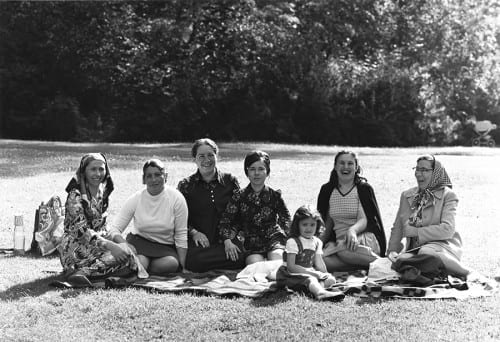
It'due south true, Mr. Interpreter, it'south the first time ever that a photograph of a Turk has been displayed in a German photo store. I've worked for more than twenty companies in Frg, in cities and in villages. I've neither heard, nor take I always seen a photo of a Turk displayed in a High german store. Every time I've gone by a photograph store I've asked myself why aren't nosotros there? Why, damn it, don't the Germans want to see us?
—Şinasi Dikman, "Hast du das Foto gesehen?"
Millions of Turkish immigrants settled in Frg later on World War II to answer the call of politicians who needed to refresh the labor force after the war. Images of Turks at work or leisure in the parks, homes, markets, shops, and bars of 1970s West German cities populate Candida Höfer's big, multiformat serial entitled Türken in Deutschland (Turks in Federal republic of germany, 1972–79). Höfer's interactions with minority subjects in these images—by turns genial, jarring, and solemn—illuminate the complicated social and cultural milieu of 1970s West Germany. The black-and-white print Volksgarten Köln | 1974, for example, evokes a genuine camaraderie between the worlds on either side of the lens. Six Turkish women and a young daughter relax on a blanket in a park, several of them looking directly at Höfer'southward photographic camera and laughing heartily, apparently at a joke shared with the photographer. Other images in Türken in Deutschland evoke the cultural collision that attended the influx of Turkish immigrants to postwar Frg. In an untitled color image from the slide bear witness Höfer finalized in 1979, the creative person concretizes the uncomfortable clash between Turkish and German cultures; an attractive begetter and daughter wearing neat white coats stand backside the glass counter of a Turkish meat store, smile in a familial way for the camera. Blood-red sausages and an assortment of discordant advertisements in Turkish and German frame the pair, competing with each other for visual attention. All the same other images evoke a sense of quietude with Höfer cast as an appreciative observer of the artifacts of the Turkish presence in Germany. In another image from the 1979 slide testify, Höfer presents a tightly framed view of the front window of a Turkish consign store. Superimposed over the store goods are the reflections of cars and buildings; rows of exotic tea sets, china, knickknacks, electronics, flags, and headscarves combine visually with the German language streetscape. At the center of this layered vision is the subtle reflection of Höfer'south own body, exposing her as the observer and framer of the scene. In these and many other images in Türken in Deutschland, Höfer explores the presence of Turkish migrants in 1970s Federal republic of germany and how that presence was alternately erased and revealed in relationships with the dominant German culture.
Türken in Deutschland circulated among gimmicky audiences in multiple, unique ways. Starting in the mid-1970s, Höfer exhibited black-and-white prints and color slide shows in galleries in her hometown of Cologne and the flourishing art scene of nearby Düsseldorf. In 1977 and 1980, Höfer too published little-known works called Diaserien, sheets of slides printed alongside advisory texts that Höfer commissioned sociologists to write about the Turks' history, civilisation, and current situation in Germany.ane The images in these Diaserien are like, sometimes identical, to those Höfer hung or projected in art venues, but they targeted audiences in schools and customs centers and aimed to piece of work with text to educate a population that suffered from a conspicuous shortage of information about the Turks.two
Höfer's images of Turkish migrants, with their straightforward depictions of politicized subjects, were anomalous at a fourth dimension when the expressive, inward-looking, and technically experimental style of "Subjective Photography" dominated photographic do in West Frg.3 (Bonn: Brüder Auer, 1952); and Fifty. Fritz Gruber, "Zum zehnten Male," paper presented at Photokina 1968: Bilder und Texte, Internationale Photo- und Kino-Ausstellung, Cologne, September 28–Oct 6, 1968.] Höfer's Türken in Frg defies corking categorization: the images do not gawk at squalid living conditions or exotic cultural practices, or even feature dramatic expressions of emotion that might make item images appear to symbolize larger problems. Instead, they express the frankness and intimacy of family snapshots, likewise as an involvement in new aesthetic mediums of the postwar advanced.
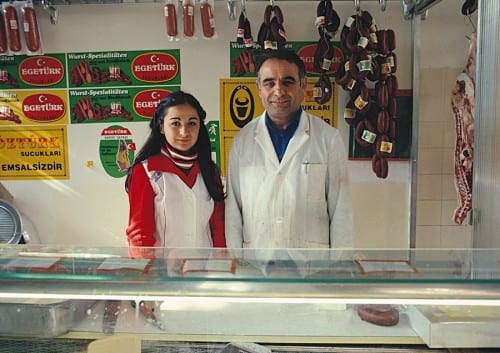
For all its historical significance and artful novelty, Türken in Deutschland is largely overlooked today, particularly outside Germany. The Guggenheim's online biography of Höfer fails to mention whatsoever of her projects from the 1960s and 1970s, instead first with her Räume (Spaces) series of the 1980s.four Her nigh recent retrospective, Candida Höfer: Düsseldorf, premiered in Germany with several 1970s images of W German Turks, yet when the exhibition traveled to New York, the early photographs were omitted in favor of presenting a harmonious vision of Höfer's do equally purely devoted to unpopulated, visually sumptuous architectural interiors.v Few curators and fine art scholars today even know of Höfer'southward Diaserien, and the artist herself claims they are no longer relevant to her oeuvre.6
Of the scholars interested in Höfer'southward work today, the few who discuss Türken in Deutschland often contextualize information technology within the and then-called Düsseldorf Photography School. Höfer, no dubiety, played a vital role in this circle by the belatedly 1980s. All the same to associate Türken in Deutschland with the Düsseldorf Photography School is to misrepresent the project as a student's emulation of her mentors' methods and aesthetics when Höfer, in fact, began Türken in Frg almost four years prior to her participation in Bernd and Hilla Becher's groundbreaking photography class at the Kunstakademie.seven Other scholars disbelieve Türken in Frg altogether as an early artistic skid into the problematics of representing social minorities from a position of greater power.8 This criticism is addressed later in this essay, yet suffice it to say that such a critique fails to recognize the immediate cultural, political, and aesthetic contexts of West Germany in the decade during which Höfer produced the work. The most significant contextual factor, I will argue, is the consistent institutionalized erasure of postwar foreigners from mainstream media and culture.
This essay seeks to analyze how Türken in Deutschland in all its formats served a social and political office in the 1970s Due west German public sphere. Specifically, it worked to gainsay representational norms in contemporary visual culture through its aesthetics, cloth formats, and modes of apportionment. To advance this merits, I first historicize Türken in Federal republic of germany past situating information technology in a fuller sociopolitical, intellectual, and cultural context. And then, I consider the projection in terms of its multiple material formats: black-and-white prints, slide shows, and slide publications. Finally, I theorize Türken in Deutschland past interpreting it equally an instance of Oskar Negt and Alexander Kluge's "counter-publicity." In their coauthored 1972 book Öffentlichkeit und Erfahrung: Zur Organisationsanalyse von bürgerlicher und proletarischer Öffentlichkeit (Public Sphere and Feel: Toward an Analysis of the Bourgeois and Proletarian Public Sphere) Negt and Kluge articulated that, in order for minorities to reach access to the democratic public sphere, they need "publicity," or representation in visual and other creative media that is rooted in their distinct life experiences.9 Höfer's photographs of Turks inhabiting everyday leisure, work, and domestic spaces in West Germany answer this call. I fence that the Diaserien and gallery projections, in detail, made Turkish migrants visible at a time when their presence in the public sphere was limited and controlled for official ends. Ultimately, Türken in Deutschland functioned in the 1970s to raise visibility and produce public soapbox for and of a disenfranchised minority group; that is to say, it was "counter-publicity."
The essay volition besides explore how Höfer's slide shows extended local art experiments with projection technologies to similarly discursive and public ends. By analyzing Türken in Deutschland in relation to these regionally centered art practices and discourses, nosotros run into that Höfer's 1970s project was actively working with pressing social debates and artistic questions beyond those typically associated with the Düsseldorf Photography School. In fact, Höfer's photographs of Turkish migrants requite us crucial insight into the artist'south career-long investigation of public space and the public sphere, and they have continued resonance in our era of mass population displacement.10
Historicizing Türken in Germany
The influx of Turkish migrants to Germany began when the Federal Republic of Germany (Due west Germany) instituted its foreign labor recruitment program in 1955 in gild to supplement the labor force afterwards the country lost almost three one thousand thousand men in World War II. The newly capitalist nation drew blue-collar workers known as Gastarbeiter, or "guest workers," from Italy (starting in 1955), Kingdom of spain (1960), Turkey (1961), Morocco (1963), Portugal (1964), Tunisia (1965), and Yugoslavia (1968).11 From the outset, policymakers presented the guest worker program to the public as strictly a temporary solution and the only viable one for the nation'due south demanding agenda for economic growth. Through the 1960s, few envisioned (or admitted) that recruiting foreign laborers would bring long-term social or cultural changes to a country already deep in an identity crisis after being divided into communist and capitalist zones.12
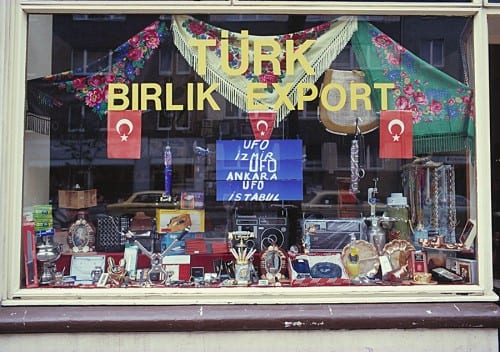
Höfer began photographing the booming Turkish guest worker community around 1972, precisely when policy changes had profound furnishings on the population demographic. Before 1970, German authorities, employers, and foreign laborers akin understood labor recruitment by its "nonpermanency"—that is to say that Germans and migrants believed laborers would return to their economically depressed nations of origin subsequently apace earning every bit much money equally possible in the Federal Commonwealth.13 However, when the international oil crunch brought the German "economic miracle" to an official halt in 1973 (and consequently, ended its labor recruitment plan), workers did not ever render to their homelands as planned. To a higher place all others, Turkish guest workers stayed and began securing resident visas for family members to join them.14 By the mid-1970s, Turks outnumbered all other foreign residents in Westward Federal republic of germany, and the initially multinational grapheme of the labor recruitment plan was largely forgotten.15 The term "invitee worker" became predominantly associated with the Turks and their particularly contested migration. While guest workers of all nationalities experienced feelings of dislocation, breach, and injustice, citizens largely perceived the Muslim Turks as the greatest threat to German culture and identity.16 As evidenced past pervasive problems with social and legal discrimination, Germans neither welcomed the Turks' presence, nor accustomed the changes the not-Western "Others" brought with them.17
Despite the dramatic increase in the Federal Republic's foreign population after 1955, popular films, books, newspapers, and advertisements of the era rarely included representations of foreigners except in ways that served policy needs or succumbed to ethnic stereotyping. The historian Rita Mentum points out that in the commencement several decades of labor recruitment, guest workers had limited visibility in the West German public sphere and restricted admission to venues for publishing firsthand literary accounts of their experiences.18 Considering foreign laborers of the fourth dimension predominantly viewed their residence in Germany equally temporary, few of them learned German. While many documented their experiences in their native languages in private journals, letters home, or foreign publications, few writings by migrants made information technology to the mainstream German language public in the early postwar decades. Thus, when discussions or representations of invitee workers did appear, Chin claims, they were offered only from the perspective of someone of the bulk class.xix This is to say that, in the 1970s when Höfer produced Türken in Deutschland, Turkish immigrants were being spoken for, if they appeared in impress or the visual surround at all, and these representations were non ever consistent with their lived experiences in Germany.
This form of silencing and erasure persisted until the 1980s, when Turkish authors began to publish poesy, brusque stories, novels, and biographies in German for majority audiences to read.twenty The excerpt from Şinasi Dikman's satirical short story "Hast du das Foto gesehen?" ("Did You See the Photo?") that begins this essay is one such instance. Dikman'due south tale powerfully describes the Turks' recognition of their exclusion from the visual environment of postwar Federal republic of germany and their attention desire for (photographic) representation. Moreover, the Turkish writer makes it plain that, even by 1983 when the story was published, Germans firmly resisted such change.
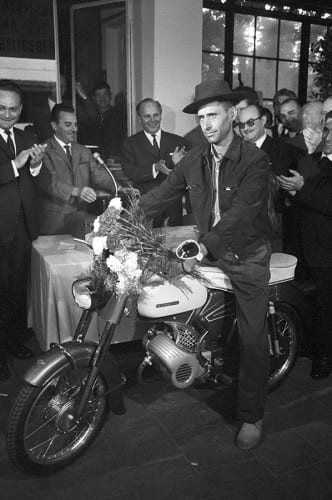
In the early postwar decades, 2 mainstream news events strongly shaped the German perception of guest workers and were intended to sway the public apropos immigration policy: the publication of both the first labor recruitment treaty with Italy in 1955 and the 1964 Deutsche Presse-Agentur photograph of Armando Rodrigues's arrival every bit the one-millionth postwar migrant worker. The first was a textual representation of the otherwise bearding foreign worker on the brink of appearing in West Germany; the treaty defined postwar guest workers unequivocally equally temporary presences in the nation and necessary for the country's economic success.21 The 2nd was the first widely circulated image of a guest worker in the public sphere. The famous photo of the public relations event depicts the able-bodied Rodrigues in a train station, holding flowers, and sitting on a motorcycle he had been given by High german officials who surroundings him and enthusiastically applaud for the camera. The photograph and its description in High german newspapers served as the authoritative "ideological construction of the guest worker in rhetoric and imagery" through the 1960s.22 Laced with patriarchal and xenophobic symbols, the photograph presented the public with an impression of the Federal Republic every bit the rich and generous benefactors of poor foreigners who would dutifully serve the nation's economic needs—and so get out.
Effectually 1972 when Höfer began photographing Turkish families and groups in public and private spaces, few additional representations of guest workers existed in mainstream media, particularly firsthand or collaborative ones. Consider the departure betwixt the Deutsche Presse-Agentur's representation of Rodrigues and Höfer'southward presentation of invitee workers. In the showtime two images of Höfer's 1979 slide evidence, a Turkish human being stands surrounded, not by German officials, but by his wife and children whom he embraces with a proud smiling. While the context of his home is express to a small corner, it is decorated smartly with an armoire and small table. Gone is the awkwardly administrative context of the Rodrigues photograph and its conscientious staging in a railroad train station, which visually reinforces the invitee worker's transient presence in Federal republic of germany. In Höfer's photographs, the Turks are not ghosts in a German world but a stock-still and growing population in the process of creating meaningful spaces of their own.
Höfer was non lonely in defying 1970s representational trends by focusing on the experiences of foreign laborers in Frg. Past the 1990s, the widespread omission of guest workers from German literature became the discipline of substantive scholarly research, and, as early every bit 1968, a tight circumvolve of avant-garde writers and filmmakers began to nowadays a fuller picture of guest workers and the living atmospheric condition they experienced in the Federal Commonwealth. Although scholars accept not nevertheless analyzed Türken in Deutschland in relation to either of these fields of report, such an analysis enhances our understanding of Höfer's art and the postwar German public sphere in which she worked. Equally this essay shows, Höfer was non working within an creative vacuum as a devotee of a single school of photography. The concepts, means of distribution, and themes at the core of Türken in Deutschland relate powerfully to the work of academics and of avant-garde writers and filmmakers of the era who analogously identified guest workers as marginalized and challenged the public with alternative visions of migrant experience.
According to Gail Wise, fifty-fifty by the early 1980s in the Federal Republic, "a dearth of popular images indeed existed, not only of Turks, but also of the millions of other foreigners who were living in West Germany equally a result of the strange worker migrations of the Fifties, Sixties, and Early Seventies."23 Past the 1990s, a group of German and American scholars had formed a new academic field to study creative culture by or nigh guest workers, termed Gastarbeiterliteratur. These intellectuals identified the pervasive practice of excluding postwar foreigners from visual and literary works every bit a kind of "silencing"—a term that describes both the language barrier well-nigh guest workers faced and their systematic exclusion from the creative, public sphere. Arlene Akiko Teraoka explains this miracle aptly in 1987. She offers examples of the way Turkish migrants are depicted as silent or prelinguistic characters in German films and plays from the late 1970s and the 1980s and argues that, during the previous xx-5 years, "from the German bespeak of view, Turks take been an indecipherable, silent presence in West High german society."24 She adds that guest workers, particularly the Turks, were and all the same are silenced past infrequent or stereotypical depictions in mainstream German scholarship and media.25 Merely by the 1980s, she claims, when Turkish foreign workers began learning German and publishing in the bulk language, did "the opaque Other" break its silence and begin to speak back to the West.26
In German novels and films of the 1960s and 1970s, Heinrich Böll, Rainer Werner Fassbinder, Helma Sanders-Brahms, and Alexander Kluge produced original, though sometimes brief, depictions of foreign laborers and the difficult challenges they faced in their nominal country. Böll received the 1971 Nobel Peace Prize for Literature later writing a pseudo-documentary novel Gruppenbild mit Matriarch (Group Portrait with Lady), which revolves effectually a adult female in postwar Germany who falls in love with a Soviet prisoner of war and develops a close friendship with a Turkish guest worker.27 In her dissertation, "Ali in Wunderland," Gail Wise criticizes Sanders-Brahms and Fassbinder for creating foreign characters that outwardly follow stereotypes about guest workers as silent, passive, or lacking in agency; yet, she claims, there are also elements in both filmmakers' works that potentially return those depictions farcical or otherwise highlight them as stereotypes to be reconsidered The woman'due south defiance of W German social norms mandating the separation betwixt citizens and all foreigners (especially betwixt women and foreigners) is an early on narrative representation of dominant stereotypes and stigmas foreign residents faced at that time.
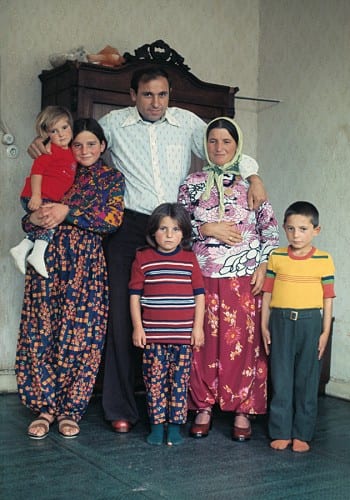
Fassbinder, the enfant terrible of New German language Cinema who established an early reputation for brazenly criticizing bourgeois values, sexual mores, prejudice, and violence, made two films that describe attention to the nation'due south securely ingrained xenophobia during the era in question. His experimental film Katzelmacher (1968) is i of the outset works in the German cultural sphere to accost detest crimes confronting invitee workers. The plot involves a grouping of bored, financially and sexually troubled young adults who direct their frustrations toward a migrant worker who moves into their apartment building. Later the guest worker (played by Fassbinder) starts dating one of the women in the grouping, the other women lash out at her verbally and the young men requite him a vicious beating. Fassbinder'south Ali: Fearfulness Eats the Soul (1974) again takes up the theme of guest workers, this time in a melodrama about a lonely, aging German language woman who develops a passionate relationship with a young, bonny Turkish worker. Because of their human relationship, the couple experiences rage from their community, bigotry, and sequestration. Both films illustrate how decisively the lines were drawn between Germans and foreigners at the fourth dimension.28
Sanders-Brahms's 1975–76 feminist motion picture Shirins Hochzeit (Shirin'south Wedding) also addresses the collision of sexual dynamics and ethnicity in West High german culture. In it, a young woman from rural Turkey, Shirin, escapes an arranged marriage to follow a human being she loves to Germany. There she finds locals who assistance her get established in the new land every bit she continues her search for him, just when she loses her job in the 1973 economic crunch, she is raped and forced into prostitution only to find her lover right before her tragic end. With Shirin'due south Wedding, Sanders-Brahms tells a story about the experiences of guest workers from a much-needed female perspective, describing the unique communities that foreign women could detect in Westward Germany, every bit well as the potential, boosted layers of sexual discrimination and violence.29
Kluge rarely addresses foreign laborers directly in his films or in his cowritten volume Public Sphere and Experience, except mayhap for a cursory scene he directed for the 1978 omnibus film Germany in Fall, in which the German law harass a Turkish man. Yet his claims that stiff democracy rests on equitable access to publicity take clear implications for the state of affairs of guest workers. Negt and Kluge firmly oppose the classist biases of earlier theories of the public sphere in their book. By expanding their theory beyond the bourgeoisie, they deduce that the production public sphere, which includes mass media and the media cartel, "oscillates between exclusion and intensified incorporation: bodily situations that cannot exist legitimated become the victims of deliberately manufactured nonpublicity."thirty Erasing Turks from mainstream visual and literary production is an expression of this concept.
Höfer would have been exposed to New German Cinema and surely to Kluge's concept of counter-publicity every bit articulated in Public Sphere and Experience.31 Her advanced art instruction began at the Kunstakademie from 1973 to 1976 in the film course of the Danish avant-garde filmmaker Ole John, who wrote and directed activist, culling films, frequently collaborating with Joseph Beuys.32 Any Höfer's direct level of exposure, when she began Türken in Deutschland, she joined these leftist writers and filmmakers in combating minority "nonpublicity" with novel photographs of the everyday spaces and experiences of Turkish guest workers.
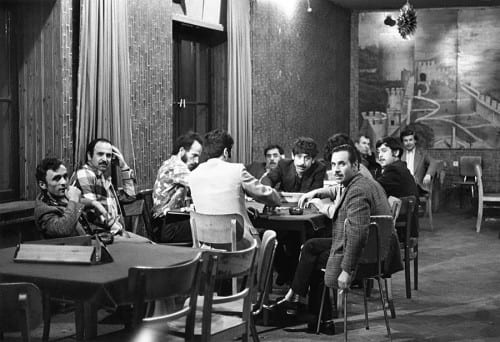
Like Shirin's Wedding, Group Portrait with Lady, and Fassbinder's films, Türken in Frg also addresses the sexual dynamics and proscriptions surrounding invitee workers and Germans. A surprising number of Höfer's images, across all formats of the series, are of all-male groups. Most of the pictures taken in stores, bars, cafes, and public streets are of all-male groups, including an extended sequence of images two-thirds of the way through the 1979 slide show and Rudolfplatz Köln | 1975 from the print serial. In these images, Höfer's "authority" every bit the creator and organizer of the gaze is undercut past strongly returned male gazes, which typically evoke some combination of amusement, suspicion, and desire. Given the projected format of the Türken in Frg slide show, the repetition of big-scale, color photographs of men staring back at the photographer with aggressive and/or flirtatious gazes has a particularly jarring effect.33 The slide depicting iv seated men staring intently at Höfer, i with an inviting half-grinning and a cigarette hanging languidly from the corner of his oral fissure, is peculiarly potent because of the epitome's unusually tight framing, which places Höfer (and the viewer) very close to their bodies. In tune with the thematic assertions in Böll'southward book and New German Cinema, Türken in Federal republic of germany makes visible the social conflicts policy makers and mainstream media producers aimed to hibernate. Yet Höfer's photography besides asserts that she, a German language and female artist, is embedded within the interpersonal, gendered, and sociopolitical dynamics of West Germany's newfound multiculturalism.
By the 1970s and 1980s, documentary-style projects similar Türken in Deutschland that depict social, racial, or economic minorities would exist characterized past some intellectuals as voyeuristic, even fierce. For example, the photography critic Susan Sontag writes in 1973 that "to photo is to advisable the affair photographed," and in 1986, Edward Said claims that "the human action of representing others almost e'er involves violence to the subject of representation."34 Such critiques of photography and other forms of visual representation are no doubt necessary correctives to the apply of pictures to reinforce racist, classist, or sexist ideologies. Yet a close examination of Türken in Deutschland in context suggests a very different motive and meaning for these photographs. In Höfer's West Germany of the 1960s and 1970s, the politically advantageous position was to erase, ignore, and silence foreigners. Historicizing Türken in Frg and analyzing its strategic use of imagery and innovative formats enables us to see how the work actively sought to challenge the public with alternative perspectives of a contested population.
This is a view that has not been taken seriously in art scholarship thus far. Even Höfer's longtime friend Benjamin Buchloh, in his first-ever essay on her fine art from 2013, critiques Türken in Germany equally non fully representing the Turks as a social category. He sees Höfer'south early project every bit a failed attempt to operate in the heritage of August Sander, and he claims that her lack of comprehensiveness renders the work voyeuristic.35 Buchloh'south essay approaches the problem of photographing others from a Marxist perspective in a mode that is highly relevant historically, yet he fails to have into account the Federal Republic's dominant practise of rendering Turks invisible in cultural product at the time Höfer was working. The 1970s do of negating the Turks in West German literary and visual civilisation was a historically and geographically specific expression of majority power and oppression of social Others that, I claim, Türken in Federal republic of germany worked against in radical, not voyeuristic, ways.
Höfer's strategies as a photographer must be distinguished from those of most European and American street photographers of before postwar decades. Höfer did not approach her documentary-style project past clandestinely shooting Turkish groups in public spaces. Instead, she talked with her subjects, asked them for permission to take their pictures, and eventually entered their homes equally a invitee.36 In an interview from 2007, Höfer describes the onset of the projection in this way:
It had all started in parks in Cologne. I felt somewhat touched by the ease with which Turkish families adopted this environment for their picnics and their family life. I became interested; I approached them; they did not mind being photographed. In time, they invited me to their homes, to their restaurants and shops, to the streets they were living in. . . . Being in their homes was non fifty-fifty mainly about photographing. They had questions to inquire, stories to tell; they had forms that needed to be filled out. I felt their strong wish to be accepted, to go integrated, to vest. And it was me who felt accepted and integrated. The friendliness with which they treated me, although I was non a fellow member of their grouping, was actually overwhelming.37
Höfer'south photographic method is characterized by compassion and respect for the Turkish community. Her sustained engagement with information technology over the class of the decade moves across hunting images of exotic Others and taking "snapshots" in the mold of Said and Sontag's distanced, trigger-happy photo-documentarian.
With Türken in Deutschland, Höfer is self-critical most her human relationship to her marginalized subjects, and she desires to do more than simply offer images of Turks for facile visual consumption. On a pictorial level, her images possess a sense of openness, reciprocity, and disquisitional analysis of visual and social ability structures. Höfer'due south subjects typically exhibit agency and a playful banter with the camera that suggests a course of photographic "giving" rather than "taking." This is clear throughout the slide show, which offers a steady stream of portraits of Turks who look back with a sense of self-presentation and congeniality—signs they are willing agents in the human action of photographic representation and have a rapport with their photographer. Höfer brings the kind of reciprocity I am describing to the fore when she includes her own faint reflection in pictures of storefront windows, placing the image of her body within the Turkish spaces and places she depicts. This strategy complicates typical power structures of the gaze, and it occurs in multiple slides of the 1979 projection. Consider, for example, the slide illustrating Turkish men in suits who all smile and direct engage with Höfer from backside the window of an imported goods store. In the center of the image, we meet Höfer'south torso reflected clearly in the storefront glass, confront obscured by her camera. The epitome is layered with objects, bodies, and architectural forms from both sides of the glass that flatten the image and place the people—a German language photographer and several Turkish subjects—on one equal airplane.
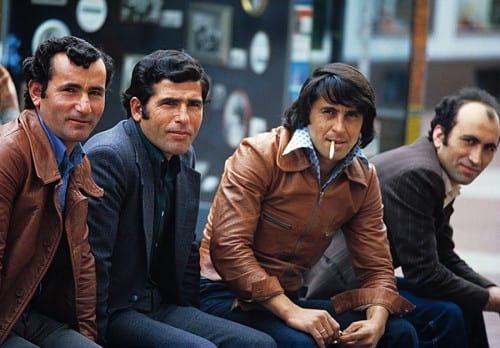
This reciprocal dynamic of looking and looking back is one of the ways in which Höfer's project affords representational agency to her minority subjects, yet the photographs also generally have a level of specificity that does not allow for the simple visual appropriation of the people on display. Viewers see some pictures of people in traditional Turkish article of clothing picnicking or gathering in ways that might be understood as "typically Turkish" and notwithstanding just as many others in contemporary, westernized fashions equally they work, shop, exercise homework, or otherwise perform the rituals of everyday life in a postwar capitalist nation. Fifty-fifty within individual slides and prints, we see multiple possibilities about how Turks negotiate their identities and experiences in Germany, as, for instance, in the wide diverseness of vesture choices and hairstyles of the women in Volksgarten Köln | 1974 or in the untitled slide depicting a young Turkish couple continuing in a kitchen wearing stylish clothing and jewelry. Hither, the room's décor shows a like attempt at mixing Turkish and Western cultures with its combination of uncomplicated tiles and utensils with Turkish carpets and a Turkish flag. Beyond the serial, Höfer does not offer a unified vision well-nigh Turkish deviation or acculturation. She visualizes Turks as embedded in the West German language social sphere without resorting to stereotypes or pathos.
The Multiple Formats of Türken in Deutschland
In the years before she created Türken in Germany, Höfer focused on producing black-and-white 35mm and medium-format photographs but was exposed to an array of other modes of expression. She interned at the historic Fotoatelier Schmülz-Huth in Cologne (1963–64), studied fine art at the Kölner Werkschulen (1964–68), and worked as a freelance photographer and artist in and around Cologne until 1970. She was shut with a circle of local leftist thinkers and advanced artists, including the anthropologist Michael Oppitz; Fritz Heubach, the editor of the contemporary fine art magazine Interfunktionen; Buchloh, a gallerist and emerging Marxist art critic; the young sculptor Isa Genzken; and the radical, mixed-media artist Sigmar Polke. Höfer's interest in the Turkish community began after a two-yr hiatus in Hamburg from 1970 to 1972.38 Upon returning habitation to Cologne, Höfer observed with fresh eyes how quickly the Turkish population had grown. While visiting Oppitz and Buchloh at their apartment, she became interested in how Turks were using the large park across the street frequently and in more social and leisurely ways than Germans.39 As more Turkish families entered the park, however, fewer High german families used the space, and the demographic of the neighborhood quickly shifted in a reactionary way that intrigued the young photographer.40 Höfer began budgeted these Turkish families and groups for permission to photograph them in black-and-white 35mm film.
In the fall of 1973, Höfer moved from Cologne to Düsseldorf, where she took up a powerful new medium: color slide projection. She finished a year of general art studies at the Kunstakademie and two years in the film course with Ole John, who encouraged her to continue documenting Turkish guest workers. It was with John's support that Höfer decided to projection color slides every bit a marriage betwixt film and photography.41 Standing in the unassuming, snapshot style of her blackness-and-white prints, she began creating multiple slide show projections from colour slides that she frequently shot in tandem with the blackness-and-white photographs. She exhibited the slide shows and prints in the 1970s and early 1980s in art galleries and museums across the Rhine region.42 The black-and-white prints take private titles, and early slide shows have distinct titles, but by 1979 Höfer had finalized the content and sequence of the eighty-paradigm slide show that she withal exhibits today. She titled it simply Türken in Deutschland, a title she at present uses to refer to the larger series. In 1977 and 1980, Höfer would try out another medium: she published sets of her slides in the form of Diaserien, or slide series, in which sheets of slides were published with sociologists' writings virtually the Turks' civilization and history. Höfer'south choices in media were not only artful but likewise political. Both the slide project and the Diaserien had an avant-garde, experimental quality, and fifty-fifty more to the point, they were vividly public in nature.
The slide show format that Höfer chose is born of a desire to address viewers in a spectacular manner and literally to change the visual environment of West Germany by projecting its marginalized, silenced people boldly into its public spaces. The works exist within a longer history of Cologne-Düsseldorf region artists using projection as an avant-garde means of intervening aesthetically in architectural sites and challenging the say-so of painting and sculpture. Artists such equally Otto Piene, Imi Knoebel, Heinz Mack, and Günther Uecker were some of the get-go in West Frg to use project technologies; they explored the medium for its potential to create social discourse and new aesthetic feel. Their work laid a foundation for immature Höfer to adopt the unusual medium in lodge to create anti-institutional spaces that combine spectacle, spatial appointment, and sociopolitical critique.43
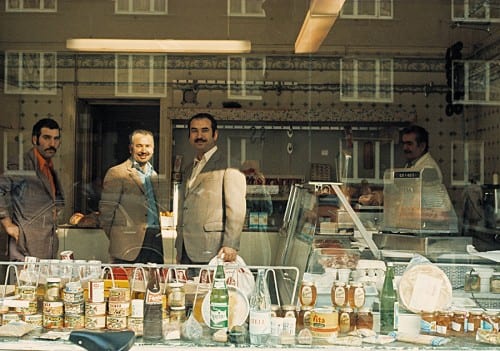
The forefather of German language projection is Piene, a student at the Düsseldorf Kunstakademie with Joseph Beuys in the 1950s and one of the founders of the experimental, new-media art collective known as Goose egg Group.44 By the late 1950s, Piene began creating artworks from low-cal projected through punctured surfaces and machines with rotating globes and discs, often set to music. The resulting array of moving lines, dots, and other shaped light forms scattered across the walls and ceilings of exhibition spaces, producing what Piene continues to call Lichtballeten (Light Ballets). His influence grew through the 1960s, both inside and beyond West Deutschland.45
The Dessau-built-in Knoebel would soon emulate Piene, by taking up the projector every bit an art tool. Knoebel studied under Beuys at the Kunstakademie (from 1964 to 1971) and began making minimalist projections of pure lite in 1969.46 Rather than adopting Piene's kinetic projection machines, Knoebel preferred the standard carousel slide projector (the kind that Höfer would later adopt) filled with bare photographic slides ofttimes marked with ink to create perfectly shaped casts of geometric light, as with Innenprojektion (1969). Between 1970 and 1972, Knoebel took the projector outdoors and drove through Darmstadt projecting a big "Ten" onto the buildings and walls of the metropolis from within his car. He recorded the action with a twoscore-minute video chosen Projektion X, in which viewers watch a continuous stream of projected lite enliven the night cityscape.
For twenty-first century viewers, a carousel slide projector may seem like a technological relic, but in the belatedly 1960s and early 1970s, it was cutting-edge visual equipment. Typically marketed to the public as a tool for teachers and salespeople, information technology was also a means for families to view their photographs at abode in large format. As artists worldwide moved abroad from traditional art mediums, some were drawn to projectors for the kinds of new creative and spatial possibilities axiomatic in Piene and Knoebel's work.47 Along with the medium's alluring scale and color, slide projections were attractive to artists because of their familiarity to viewers. Darsie Alexander points out that by the 1960s "slide projection represented a common 'language' that the general public could sympathize, but it also engaged the concerns of artists seeking to explore the principles of art as a fugitive process, a project of ideas and images."48 The medium's accessibility and ability to display a combination of "ideas and images" in a novel, public fashion are fundamental to the style Höfer's slide shows and Diaserien functioned in the 1970s.
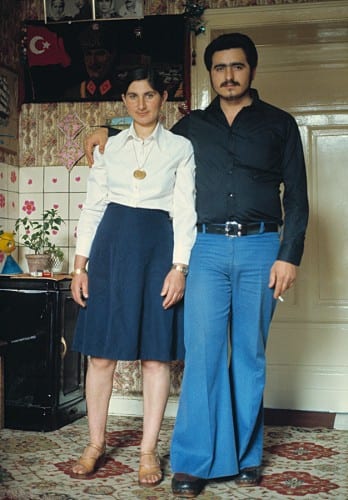
Although slide show projections are generated from photographic images, they radically depart from traditional color or black-and-white prints in their visual impact. For viewers accustomed to looking at static paintings and sculptures, projected images possessed a new temporality, scale, and psychological power. Doreen Bolger points out that from atomic photographic slides, artists from the 1960s on "accept produced magnificent images, projected with an unsurpassed clarity and intense colour on a scale that exceeds even the most ambitious paintings of the time."49 Artists of the postwar era experimented widely with the timing and sequencing of images in their slide shows, specifically considering such factors could change the consequence of their images on viewers and exam the way people were accepted to looking at art. In this way, Alexander claims, "The medium thus played upon and accentuated ane of the almost significant aspects of performance fine art: information technology was a form of human soapbox, promoting a dynamic interaction between people, politics, and art."fifty
Post-obit Piene's Lichtballeten, he and other Düsseldorf artists of the late 1960s began thinking of projection in increasingly discursive, environmental, and embodied terms. From the onset of their collaboration as Zero Grouping, Piene, Mack, and Uecker held 1-dark exhibitions and deportment or demonstrations as a means of exhibiting their work; in the 1960s, Uecker carried the grouping's self-proclaimed interests in making "works of calorie-free and movement, infinite and time, dynamics and vibration" to an experimental art infinite and disco in Düsseldorf called Creamcheese.51 When it opened in July 1967, at 12 Neubrückstrasse in the onetime town, near the Düsseldorf Kunstakademie, Creamcheese was conceived as a space to combine pop and electronic music with slide projections, light shows, films, and other visual objects or installations.52 The filmmaker Lutz Mommartz and the media artist Ferdinand Kriwet worked together at Creamcheese to facilitate local artists' apply of the edifice for Happenings, events centering on the brandish of large-calibration 2-dimensional fine art works and of multiple simultaneous projections of lite, pictures, and text. In the tradition of Piene and Knoebel's spatialized projections, the order's visitors would dance in and effectually the beams of light and imagery, becoming part of the environment.
Höfer'south offset exhibition of her slide projections took identify in 1975 at Konrad Fischer's small Neubrückstraße gallery about Creamcheese. Fischer built the exhibition space in 1967 (the same year Creamcheese opened) by enclosing the open up finish of a small, covered alleyway with large drinking glass doors, leaving the interior of the gallery visible to street traffic. By the time of Höfer's exhibition, Fischer was using the space for piece of work by emerging local artists. For her exhibition, Höfer installed 2 projectors with color slide shows, one of images of Turks living in West Germany and another of Turks in their homeland that she and Gerard Osborne had shot that summer.53 Thus from the street the Creamcheese crowd, which consisted of many Kunstakademie students and teachers as well as local artists, filmmakers, and musicians, could see a double project of large-scale, color images of the booming Turkish customs late into the night.54 Extending the tradition of artists before her, Höfer transformed her politicized images into spectacular and environmental works of art.
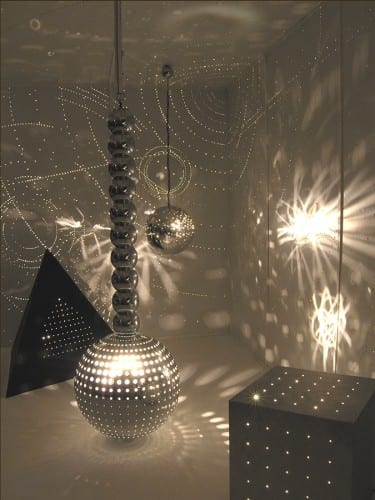
Even as her double project in a glass-box gallery rhymed with the spatial projections in Creamcheese, Höfer'southward work was much more than explicit than Piene, Knoebel, and Uecker's in its sociopolitical ambitions. Höfer and Osborne chose a title that emphasized the demand for activeness—"WAS non tut . . . ist eine weitgehende Integration der Gastarbeiter" (WHAT Is Needed . . . is a far-reaching integration of guest workers)—and included examples of structural hostility confronting the Turks with a brandish of newspapers referring to guest-worker stereotypes.55 For the art critic Gislind Nabakowski, and I doubtable many of the locals passing by Fischer'southward gallery, Höfer'southward projections were understood every bit a pointed attack on policies concerning minorities.56 They were a bold, spectacular phone call for discourse and action to help integrate Turkish immigrants. Her imagery offered a disenfranchised minority the kind of "counter-publicity" that Negt and Kluge (and the New Left) felt was necessary to bring a working-grade population to equality in the young Federal Republic.
Just as Höfer's slide projections used a new art medium to create immersive imagery that, in itself, generated a counter-public sphere in 1970s Frg, so as well her Diaserien operated with similar discursiveness. The published slides and text, though, were designed and distributed to achieve non-art audiences. At the time of publication, few sociological or cultural texts were available on Turkish customs, history, and behavior to aid High german readers develop a greater understanding of their new neighbors—and to help Turkish immigrants understand themselves as inhabitants of Germany. The sociologists whom Höfer asked to writer Alltag in der Türkei wrote that the shared ambition of the trio was for the projected slides and text to be used together to help, for instance, Turkish schoolchildren bridge the gap between their home lives and the public schools where they were broadly identified equally struggling.57 Seeing images of Turkish families in their homeland and reading information about their history and civilisation would, Höfer and the sociologists hoped, encourage minority children to talk in front of their German peers near their new lives and struggles in the Federal Democracy. In the 1980 publication, Türken in Frg, the authors describe how they did, in fact, have the projections to schools, and they vividly recount some of the children's observations in the classroom conversations that ensued virtually cultural differences between Germans and Turks and the children'due south emotional responses to those differences.58
The Diaserien drew on the circulation possibilities of the literary public sphere and the public nature of sites similar schools and community centers as ways to generate increased discourse about Turkish minorities and their experiences in the Federal Democracy. Höfer's distribution of factual text and public projections of slides asserted the Turkish community's established, proletarian presence in West Germany. Further, the works alleged the demand for increased give-and-take about Turkish acculturation and the need for Germans to accept their nation's newfound multiculturalism, despite official rhetoric to the contrary and mainstream media'due south methods of minority erasure.
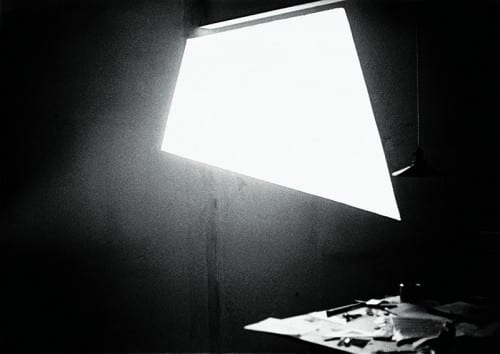
Theorizing Türken in Deutschland as Counter-Publicity
Up to this point, nosotros take been analyzing Türken in Deutschland in its aesthetic, historical, and intellectual context at the time of its cosmos and initial distribution. Now we plough with greater specificity to the concept of Öffentlichkeit, or the "public sphere," revitalized in the 1960s by the Düsseldorf-born philosopher Jürgen Habermas. The term refers to the public spaces that emerged in Europe at the finish of the seventeenth century, including cafes, literary salons, and impress media, to facilitate wide debates about social needs, rules, and governance. Habermas argues these conservative public spaces and the rational critical debate produced within are necessary for the germination and maintenance of a fully democratic guild, yet they withered in the late nineteenth and the twentieth centuries under the force of mass media acting in complicity with avant-garde capitalism—an argument that aligns his piece of work decisively with Marxist ideas of the fourth dimension. Habermas laid out his claims in a 1962 book entitled Strukturwandel der Öffentlichkeit: Untersuchungen zu einer Kategorie der bürgerlichen Gesellschaft, which was translated in 1989 as The Structural Transformation of the Public Sphere: An Inquiry into a Category of Bourgeois Society.59 His widely read text brought the concept of the public sphere to the center of debates about the postwar status of democracy in the German New Left circles of the 1960s.60
Habermas'southward notion that the bourgeois public sphere was open up and attainable to all gave it a radically democratic appeal. However, equally Habermas admits, it ultimately failed to attain that goal and, in reality, was limited to males of specific economic classes. These limitations would somewhen fall nether widespread critique. The Structural Transformation of the Public Sphere was also initially understood as supportive of the student movement's protests against the government and the monopolized, conservative mass media in West Germany. However, by the terminate of the 1960s, Habermas'south relationship with the pupil generation went cold, every bit he publicly accused student activists of producing trigger-happy and senseless "action for action'south sake" in what he chosen a grade of "Leftist Fascism."61 The New Left retaliated past increasingly seeking theoretical support from those outside what they considered to be the ivory tower of the Frankfurt School subsequently Theodor Adorno'south death.62 It was from this backlash against Habermas that the concept of counter-publicity emerged.
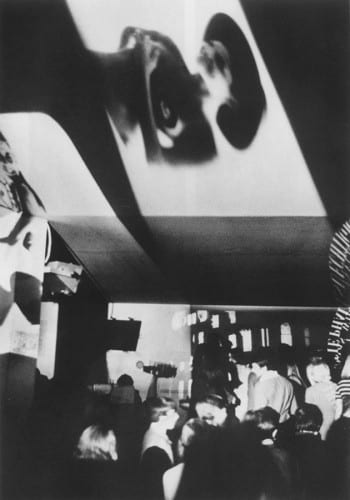
In 1972 Negt and Kluge—Habermas'due south erstwhile assistant and a key figure in New German Cinema, respectively—published an ambitious response to Habermasian theories with The Public Sphere and Feel. They advanced the concept of counter-publicity to denote the marginalized, merely meaningful, discourses of those outside the ascendant public sphere. Negt and Kluge's text represented an important turning indicate in debates about publicity in that it immune for the inclusion of working-class and minority groups every bit well every bit the individual experiences typically understood as outside rational, autonomous fence—amendments well received by the New Left. In The Public Sphere and Feel, Negt and Kluge state that the main trouble the proletariat faces is that the conservative public sphere "blocks" the one-time's "horizon of social experience," including the individual, business organisation, and "accurate" aspects of daily life.63 They claim that the expression of everyday proletarian experience in fine art, visual culture, or motion-picture show is non a trivial act that stands outside civil discourse; instead, it is essential for forming an emancipatory "counter-public." As such, Negt and Kluge'south concept of Erfahrung ("everyday experience") gained currency throughout the decade in leftist and artistic circles.
We meet a leftist interest in Erfahrung plainly in Höfer'due south focus on documenting the everyday spaces and experiences of the disenfranchised West High german Turks—like picnicking in parks, selling sausages in a meat shop, or casually standing with loved ones within one'due south home. Past projecting such banal, working-form experiences vibrantly in public art exhibitions or distributing them to non-art audiences for display and discussion, Höfer challenged Habermas's tightly defined notions of what was acceptable in public soapbox and generated a radical counter-public in Negt and Kluge'southward terms.
For German language audiences in the 1970s, Höfer's Türken in Deutschland series served as a record of the unjust fact that Turkish migrants had an established presence in Due west Frg without existence granted citizenship or a political voice. For the photographer, the images served as an inscription of herself into the imbalanced social system of the fourth dimension. The Türken in Deutschland series affirmed the creative person's 1970s appetite to tape the encounter between two communities—a visual argument that ran counter to popular rhetoric, which denied the need for minority integration. When displayed as big-calibration colour projections or distributed as Diaserien, the images assertively called for public debate about a people rendered visually and socially taboo and asked Turkish immigrants to conceive of themselves equally a visible, meaningful presence in W Frg. Every bit such, the project was a "communicative praxis" that strove for cypher less than a counter-public in postwar West Germany: "an alternative organization of the public sphere."64 stakes out claims for a communicative praxis, which is the basis for an alternative organization of the public sphere" (53).]
The writer would like to thank Pamela K. Lee, Pavle Levi, Fred Turner, and Bryan J. Wolf for their support and feedback on before versions of this essay. She also thanks Candida Höfer, Michael Oppitz, and the Candida Höfer-Stiftung for sharing their fourth dimension, resources, and inventiveness, without which this project would not have been possible.
The epigraph is from Şinasi Dikman, "Hast du das Foto gesehen?" in Wir werden das Knoblauchkind schon schaukeln: Satiren, ed. Ellen Imhof and Gisela Klump, vol. 10 of AutorenEXpress (Berlin: Express Edition, 1983), 59, trans. Gail Wise, "Ali in Wunderland: German Representations of Strange Workers" (PhD diss., Academy of California, Berkeley, 1995), ii.
Amy A. DaPonte is a instructor, scholar, and onetime architectural designer. Her enquiry focuses on the history, aesthetics, and sociopolitical implications of German fine art in the postwar era. Electric current writing projects include an article on Günther Förg's postmodern Stations of the Cross series of monotypes and sculptural panels and a book manuscript based on her dissertation, "Disquisitional Publicity: Candida Höfer's Public Space Photographs, 1968–present."
Source: http://artjournal.collegeart.org/?p=7992
0 Response to "What Is Meyers Beef With the Germans in Turks"
Post a Comment